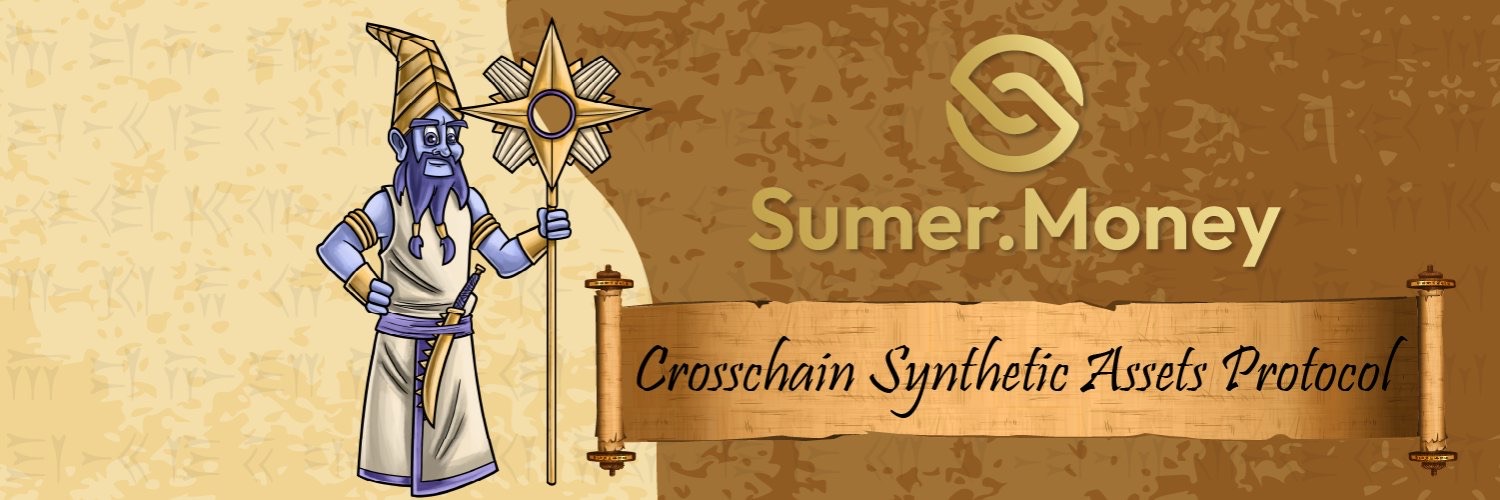I thought about Sumer.Money and wrote what I thought. Please take a look if you like.
Sumer.Money: Revolutionizing DeFi with Cross-Chain Synthetic Assets
Introduction:
Sumer.Money is a groundbreaking cross-chain synthetic assets protocol designed to simplify and secure the world of decentralized finance (DeFi). By offering a lending and borrowing market accessible across multiple supported blockchains, Sumer.Money aims to provide users with a credit card-like experience, facilitating seamless smart contract communications and enhancing multichain liquidity.
The Rise of Multi-Chain Ecosystems:
The growth of Decentralized Finance (DeFi) and the multi-chain ecosystem has been nothing short of spectacular. As WEB3 and blockchain technologies continue to gain traction, the network effect will be pivotal in bringing new users, enterprises, and developers into this dynamic ecosystem. The future of blockchain platforms resembles the mid-1990s internet, both in terms of infrastructure and catalyzing innovative business models.
Embracing Multi-Chain Realities:
Enterprises are poised to adopt blockchain technology, each with its unique objectives and use cases. This diversity necessitates various architecture, consensus mechanisms, token types, and other characteristics, paving the way for a multi-chain ecosystem. Even within similar applications like DeFi and NFTs, a single blockchain infrastructure falls short in achieving mass adoption.
Scaling the Blockchain Ecosystem:
Much like the internet scaled through TCP/IP protocols, the blockchain ecosystem is set to horizontally expand, enabling seamless enterprise network communications and broadening audience reach. However, the introduction of new blockchain networks and decentralized applications has introduced inefficiencies at the core of WEB3 adoption, particularly with regard to assets and tokens.
The Challenge of DeFi Composability:
The DeFi composability has been hindered by the introduction of new blockchain networks and decentralized applications. Key challenges include the introduction of wrapped assets that lack fungibility with their native counterparts on the same chain, as well as interoperability issues stemming from different bridging solutions.
Unveiling Sumer.Money: The Missing Piece in DeFi Lego:
Sumer.Money addresses one of the most crucial aspects of the blockchain token economy – crypto assets. It seamlessly facilitates the travel and interaction of assets and smart contracts across various platforms, akin to the TCP/IP protocol for the financial Internet. Sumer.Money introduces a credit card-like experience with its new multi-chain composable synthetic asset class, unlocking DeFi’s latent potential.
Key Characteristics of Sumer.Money:
Sumer’s multichain synthetic assets offer a credit card-like experience, promoting multichain liquidity and seamless cross-chain smart contract communications. DeFi users can deposit assets like ETH, BTC, USDC, USDT, BUSD, etc., on the native blockchain to mint synthetic assets (SuUSD, SuETH, SuBTC) that are fungible across the entire supported network of blockchains.
The Sumer Protocol: A Comprehensive Lending and Borrowing Solution:
The Sumer Protocol encompasses a Compound-inspired lending and borrowing system, allowing users to deposit native assets, mint SuTokens against them, borrow native assets against deposited assets or SuTokens, and repay borrowed assets. This ecosystem is designed to smoothen out volatility in collateral, minimizing risk exposure.
Asset Group Classification:
Sumer introduces the concept of asset groups, distinguishing between homogeneous and heterogeneous assets. Homogeneous assets share similar value, liquidity, and risk profiles (e.g., USDC, USDT, BUSD), while heterogeneous assets have varying characteristics (e.g., USDC, ETH, BTC). Understanding these groups is crucial for determining collateral limits and loan-to-value ratios.
Interest Rate Model:
Sumer Protocol adopts a variable interest rate model, influenced by the supply and demand of assets. The computation of interest rates employs a Standard model and a Jump (Kink) model, incentivizing or disincentivizing depositing and borrowing activity.
Conclusion:
Sumer.Money’s innovative approach to cross-chain synthetic assets sets a new standard for DeFi. By breaking down liquidity and smart contract communication barriers, Sumer.Money offers a secure, seamless, and decentralized financial experience for users across various blockchains. Its introduction marks a significant milestone in the evolution of DeFi and the broader blockchain ecosystem.
We are expanding our activities further by developing a testnet on the Meter_IO network.Sumer.Money will never stop evolving.We recommend that you pay attention to this project.
